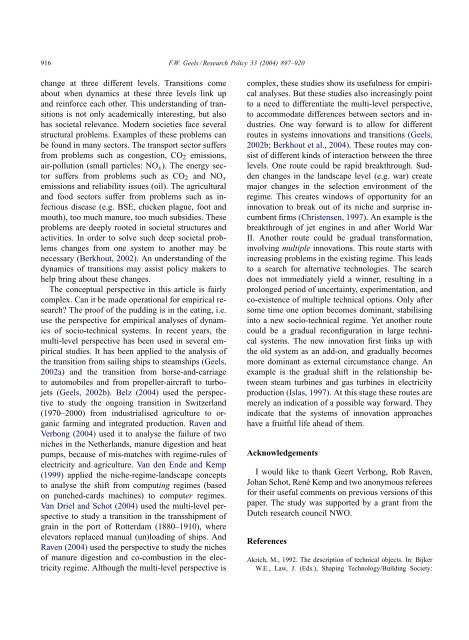From sectoral systems of innovation to socio-technical systems ...
From sectoral systems of innovation to socio-technical systems ...
From sectoral systems of innovation to socio-technical systems ...
You also want an ePaper? Increase the reach of your titles
YUMPU automatically turns print PDFs into web optimized ePapers that Google loves.
916 F.W. Geels / Research Policy 33 (2004) 897–920<br />
change at three different levels. Transitions come<br />
about when dynamics at these three levels link up<br />
and reinforce each other. This understanding <strong>of</strong> transitions<br />
is not only academically interesting, but also<br />
has societal relevance. Modern societies face several<br />
structural problems. Examples <strong>of</strong> these problems can<br />
be found in many sec<strong>to</strong>rs. The transport sec<strong>to</strong>r suffers<br />
from problems such as congestion, CO 2 emissions,<br />
air-pollution (small particles: NO x ). The energy sec<strong>to</strong>r<br />
suffers from problems such as CO 2 and NO x<br />
emissions and reliability issues (oil). The agricultural<br />
and food sec<strong>to</strong>rs suffer from problems such as infectious<br />
disease (e.g. BSE, chicken plague, foot and<br />
mouth), <strong>to</strong>o much manure, <strong>to</strong>o much subsidies. These<br />
problems are deeply rooted in societal structures and<br />
activities. In order <strong>to</strong> solve such deep societal problems<br />
changes from one system <strong>to</strong> another may be<br />
necessary (Berkhout, 2002). An understanding <strong>of</strong> the<br />
dynamics <strong>of</strong> transitions may assist policy makers <strong>to</strong><br />
help bring about these changes.<br />
The conceptual perspective in this article is fairly<br />
complex. Can it be made operational for empirical research?<br />
The pro<strong>of</strong> <strong>of</strong> the pudding is in the eating, i.e.<br />
use the perspective for empirical analyses <strong>of</strong> dynamics<br />
<strong>of</strong> <strong>socio</strong>-<strong>technical</strong> <strong>systems</strong>. In recent years, the<br />
multi-level perspective has been used in several empirical<br />
studies. It has been applied <strong>to</strong> the analysis <strong>of</strong><br />
the transition from sailing ships <strong>to</strong> steamships (Geels,<br />
2002a) and the transition from horse-and-carriage<br />
<strong>to</strong> au<strong>to</strong>mobiles and from propeller-aircraft <strong>to</strong> turbojets<br />
(Geels, 2002b). Belz (2004) used the perspective<br />
<strong>to</strong> study the ongoing transition in Switzerland<br />
(1970–2000) from industrialised agriculture <strong>to</strong> organic<br />
farming and integrated production. Raven and<br />
Verbong (2004) used it <strong>to</strong> analyse the failure <strong>of</strong> two<br />
niches in the Netherlands, manure digestion and heat<br />
pumps, because <strong>of</strong> mis-matches with regime-rules <strong>of</strong><br />
electricity and agriculture. Van den Ende and Kemp<br />
(1999) applied the niche-regime-landscape concepts<br />
<strong>to</strong> analyse the shift from computing regimes (based<br />
on punched-cards machines) <strong>to</strong> computer regimes.<br />
Van Driel and Schot (2004) used the multi-level perspective<br />
<strong>to</strong> study a transition in the transshipment <strong>of</strong><br />
grain in the port <strong>of</strong> Rotterdam (1880–1910), where<br />
eleva<strong>to</strong>rs replaced manual (un)loading <strong>of</strong> ships. And<br />
Raven (2004) used the perspective <strong>to</strong> study the niches<br />
<strong>of</strong> manure digestion and co-combustion in the electricity<br />
regime. Although the multi-level perspective is<br />
complex, these studies show its usefulness for empirical<br />
analyses. But these studies also increasingly point<br />
<strong>to</strong> a need <strong>to</strong> differentiate the multi-level perspective,<br />
<strong>to</strong> accommodate differences between sec<strong>to</strong>rs and industries.<br />
One way forward is <strong>to</strong> allow for different<br />
routes in <strong>systems</strong> <strong>innovation</strong>s and transitions (Geels,<br />
2002b; Berkhout et al., 2004). These routes may consist<br />
<strong>of</strong> different kinds <strong>of</strong> interaction between the three<br />
levels. One route could be rapid breakthrough. Sudden<br />
changes in the landscape level (e.g. war) create<br />
major changes in the selection environment <strong>of</strong> the<br />
regime. This creates windows <strong>of</strong> opportunity for an<br />
<strong>innovation</strong> <strong>to</strong> break out <strong>of</strong> its niche and surprise incumbent<br />
firms (Christensen, 1997). An example is the<br />
breakthrough <strong>of</strong> jet engines in and after World War<br />
II. Another route could be gradual transformation,<br />
involving multiple <strong>innovation</strong>s. This route starts with<br />
increasing problems in the existing regime. This leads<br />
<strong>to</strong> a search for alternative technologies. The search<br />
does not immediately yield a winner, resulting in a<br />
prolonged period <strong>of</strong> uncertainty, experimentation, and<br />
co-existence <strong>of</strong> multiple <strong>technical</strong> options. Only after<br />
some time one option becomes dominant, stabilising<br />
in<strong>to</strong> a new <strong>socio</strong>-<strong>technical</strong> regime. Yet another route<br />
could be a gradual reconfiguration in large <strong>technical</strong><br />
<strong>systems</strong>. The new <strong>innovation</strong> first links up with<br />
the old system as an add-on, and gradually becomes<br />
more dominant as external circumstance change. An<br />
example is the gradual shift in the relationship between<br />
steam turbines and gas turbines in electricity<br />
production (Islas, 1997). At this stage these routes are<br />
merely an indication <strong>of</strong> a possible way forward. They<br />
indicate that the <strong>systems</strong> <strong>of</strong> <strong>innovation</strong> approaches<br />
have a fruitful life ahead <strong>of</strong> them.<br />
Acknowledgements<br />
I would like <strong>to</strong> thank Geert Verbong, Rob Raven,<br />
Johan Schot, René Kemp and two anonymous referees<br />
for their useful comments on previous versions <strong>of</strong> this<br />
paper. The study was supported by a grant from the<br />
Dutch research council NWO.<br />
References<br />
Akrich, M., 1992. The description <strong>of</strong> <strong>technical</strong> objects. In: Bijker<br />
W.E., Law, J. (Eds.), Shaping Technology/Building Society:



